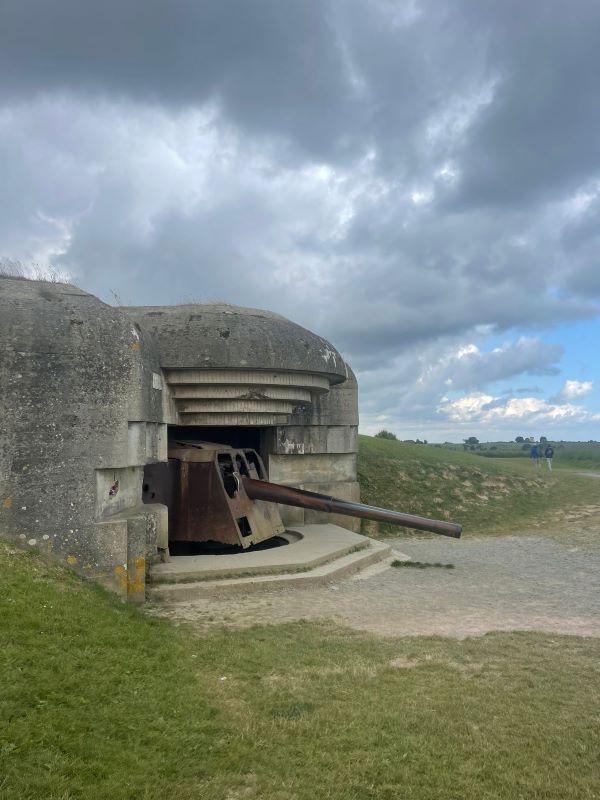The D-Day Landing Beaches
D-Day Beaches: A journey through history
On June 6, 1944, known as "D-Day" or "the longest day," marked the beginning of a massive military operation. Nearly 132,000 Allied soldiers, from the United States, the United Kingdom, Canada, France, and other nations, landed on 80 kilometres of Normandy coastline, from Sainte-Marie-du-Mont to Ouistreham. These young soldiers courageously paved the way for the liberation of Europe. Let's explore the iconic sites of this historical operation. Visit possible either per site, on a half day (up to three sites in the same area), or on a full day (up to five sites in the same area).
- Pointe du hoc Pointe du Hoc, a 30-meter-high cliff, was a strategic objective for the 2nd American Ranger Battalion. Defended by a German battery, this cliff still bears the marks of the intense battles that took place there. Bombardments and assaults have left visible traces, making this site a poignant testimony to the confrontations.
Duration of the visit: 1h30.
- Omaha Beach : Omaha Beach, nicknamed "Bloody Omaha," is infamous for the heavy losses suffered by the Allied troops. Stretching 6 kilometers, this beach saw combat units decimated by enemy fire and the rising tide. From the beach and a German strongpoint, one can understand why this beach earned its nickname.
Duration of the visit: 1h.
- American Cemetery of Colleville-sur-Mer : Located above Omaha Beach, this cemetery is a solemn place of remembrance. It honors the American soldiers who lost their lives during the D-Day landings and the subsequent battles in Normandy. A poignant place to remember the sacrifices made.
Duration of the visit: 1h.
- Longues-sur-Mer German Gun Battery : This site offers a unique perspective on German defenses and their impact on Allied operations. The casemates still house the cannons that fired on the Allies on June 6, 1944, making this place an open-air museum.
Duration of the visit: 1h30.
- Arromanches : Arromanches, a small fishing village, was transformed into an important radar base during the German occupation. At the Liberation, it became the site of one of the greatest logistical adventures of World War II, thanks to its artificial port, the famous Port Winston. Testimonials and archival images allow visitors to relive the key moments of the Liberation.
Duration of the visit: 1h30.
- Gold Beach : Among the five designated assault beaches, Gold Beach held a central position. It was assigned to the 50th British Infantry Division. The assault aimed to secure Arromanches and capture the German battery at Longues-sur-Mer. After intense fighting, the Allies neutralized enemy defences and secured key villages, facilitating the advance toward Bayeux. Today, Gold Beach is a place of remembrance, notably with the Ver-sur-Mer Memorial, dedicated to British and Commonwealth soldiers.
Duration of the visit: 1h30.
- Utah Beach : Utah Beach witnessed the landing of the 4th American Infantry Division under General Barton. Although less deadly than Omaha Beach, Utah Beach remains crucial for understanding Operation Overlord.
Duration of the visit: 45 minutes.
- Sainte-Mère-Église : The village of Sainte-Mère-Église was captured by the 3rd Battalion of the 505th Regiment of the 82nd Airborne and elements of the 101st Airborne. This landing was marked by the largest paratrooper drop in history, an unmatched feat. The paratroopers displayed exemplary courage in repelling enemy counterattacks.
Duration of the visit: 1h.
- Pegasus-Bridge : The Bénouville Bridge, known as Pegasus Bridge, was captured by the 6th British Airborne Division. This strategic bridge over the Caen Canal to the sea was crucial for the success of the D-Day landings. The airborne troops managed to capture the bridge in a few minutes, despite German resistance. Duration of the visit: 45 minutes.
- Sword Beach : Sword Beach, located at the eastern end of the Allied sector, was the scene of fierce fighting between British troops and German forces. The 3rd British Infantry Division and the 4th Commando, including 177 French Marines under the command of Philippe Kieffer, secured the beach despite fierce resistance. The troops quickly advanced inland, aiming for Caen.
- Juno Beach : Juno Beach, situated between Sword and Gold Beach, saw Canadian troops of the 3rd Infantry Division face fierce German resistance. Despite the obstacles, Canadian soldiers penetrated enemy defenses and advanced inland. Juno Beach has become a symbol of Canadian bravery and determination to liberate Europe. It was also on this beach that diplomatic figures like Churchill and De Gaulle landed.
Duration of the visit: 1h.
These iconic sites pay tribute to the heroes of D-Day and help us understand the magnitude of this historical operation.





